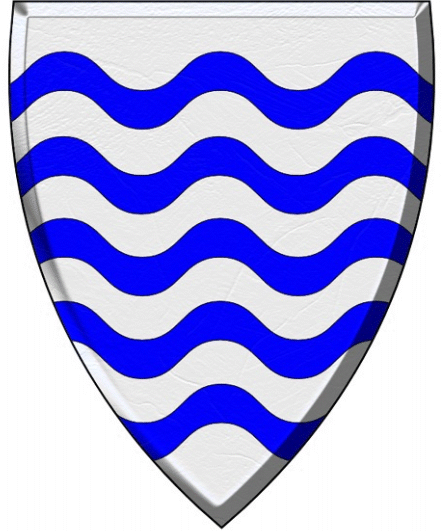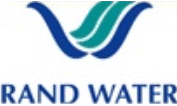

Rand Water Board

THE fad for graphic art logos has removed this strikingly simple coat of arms from public view, and replaced it with a rather trite symbol that purports to show a waterbird masquerading as waves.
This symbol is used by the authority under its current name, Rand Water.
The Bureau of Heraldry registered arms for the board under a certificate issued on 6 January 1972, the blazon reading:
Arms: Argent, five bars wavy Azure.
Crest: Standing amidst water-lily flowers and leaves, the figure of a maiden vested proper, bearing on the sinister shoulder a vase Or, decanting water proper.
Wreath and mantling: Argent and Azure.
Motto: EX AQUA VITA.

For the moment only the shield is illustrated; an artistic representation of the crest and motto will follow shortly.
Heraldry has since its earliest days used wavy lines, especially in silver and blue, to symbolise water. The shield is thus the simplest and most direct statement of the board’s function that could be made.
The crest is perhaps an overstatement of this function, but goes to underline the human element in water provision, as well as the importance of the cleanliness of this vital medium.
The motto translates as “Out of water, life.”
About the board:
The Rand Water website incorporates an article on the history of the board which is quoted here:
“From the time of the discovery of gold on the Witwatersrand in 1886,[1] the supply of water was entirely in the hands of private companies until 1903.[2] The price was high and supply was erratic.
“After the appointment of various governmental commissions, it was decided that the Rand Water Supply Board should be constituted by legislation. The board was given certain powers for the exploitation of water, could raise loans and arrange for their repayment, as well as lay down tariffs for the sale of water.
“An important policy decision was that there would be a fixed rate per thousand gallons, irrespective of the point on the trunk lines from which the supply was drawn. This meant that the Witwatersrand could develop independently of where the source of water was. Another important decision was that the rate for water was not to yield any profit, but was calculated to cover working costs.
“The Rand Water Board’s constitution was largely based on London’s Metropolitan Water Board (1902), but whereas the latter supplied water to individual consumers, the Rand Water Board supplies water in bulk only.
“The first annual report of the board for the year ending on 31 March 1906 showed that the annual daily consumption of water was about 11 megalitres a day. The greatest problem facing the board, then as now, was the need to augment its water resources to meet the growing demand for water as the population and industrial activities increased and continue to increase.
Development of the Vaal Barrage:
“In 1914[3] the Board adopted the Vaal Development Scheme that involved the construction of the Barrage and the provision of a purification and pumping works at Vereeniging. The scheme was eventually completed in 1923. It was the first major river development scheme on the Vaal River.
“The public was now assured that the frequent cutting of supplies during the dry season were at an end, and it would be forty years before restrictions on the use of water would be imposed again.
“Since 1924, additional water supply schemes were approved by the Rand Water Board in 1924, 1927, 1931, 1933, 1935, 1937, 1938, 1941, 1946, 1949, 1953, 1965, 1970, 19__. [sic][4]
“The board’s planning is based on actual operating experience and on estimates of water requirements obtained from consumers at regular intervals. Virtually all the machinery, pipelines and reservoirs are designed to meet the demand for the ensuing five or 10 years, and generally longer.
Water purification:
“Prior to obtaining its water from the Vaal River, the Rand Water Board had no undue problems in rendering the water at its disposal safe. This is chiefly due to the fact that underground sources were used.
“In resorting to water from the Vaal Barrage, the board realised that great attention had to be paid to the purification of raw water from surface run-off before it could safely be put into supply.
“Sedimentation tanks to purify the minute clay particles characteristic of the Vaal water were installed in the Vereeniging station’s treatment works. These were based on those used in Egypt to purify the water of the Nile.
“However, after the sedimentation process, the water still contains about 5% of suspended matter, and this is removed by means of rapid gravity filtration. The adoption of this method back in 1923 has stood the board in good stead ever since. The water is then sterilised by chlorination (liquid chlorine has proved effective since 1925).
“Extensive bacteriological testing takes place before the water is released into Rand Water’s distribution system.
Pipelines and pumping:
“The main axis of Rand Water’s water supply system runs from south to north, from Vereeniging to Pretoria. Urban and industrial development stretches across this axis, running west to east from Krugersdorp to Springs.
Rand Water has considerable powers with regard to the laying of pipelines across land and properties. However, the establishment of pipeline routes has become increasingly difficult as the complexities of industrial development intensify.
“Pumping has always played a huge role in Rand Water’s engineering activities since water has to be lifted about 380 metres from the Vaal River to the higher areas of the Witwatersrand. There are few water supply organisations in the world that has to expend as much energy as RandWater on pumping plants.”
Other water authorities:
Rand Water is by far the largest water utility in South Africa in terms of volume delivered, although there are numerous other water utilities and irrigation boards across the country.
What these authorities all have in common is that they distribute a scarce commodity. This is in complete contrast to the Waterschappen of the Netherlands, which primarily have to deal with an overabundance of water, although they additionally also supply fresh water.
The arms of the Rand Water Board can nonetheless be seen as a South African equivalent of the Waterschappen, which have for centuries borne arms.
[1] In the time of the Zuid-Afrikaansche Republiek.
[2] In the time of the Transvaal Colony.
[3] When the Witwatersrand was part of the Transvaal Province following Union.
[4] This list of dates, the final date being obscured, is the way this quotation appears on the Rand Water website.

Vir Afrikaans, kliek hier
Arms drawn by Barrie Burr; Rand Water logo from the utility’s website.
Back to Armoria corporativa index
Comments, queries: Mike Oettle